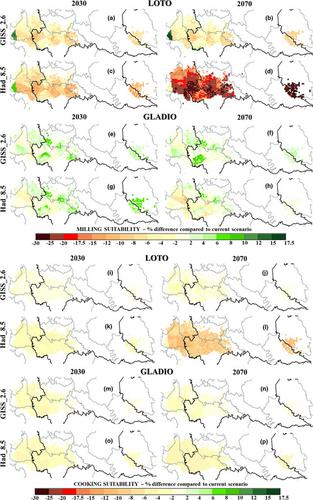当前位置:
X-MOL 学术
›
Food Energy Secur.
›
论文详情
Our official English website, www.x-mol.net, welcomes your
feedback! (Note: you will need to create a separate account there.)
Model-based evaluation of climate change impacts on rice grain quality in the main European rice district
Food and Energy Security ( IF 4.0 ) Pub Date : 2021-06-29 , DOI: 10.1002/fes3.307 Giovanni Alessandro Cappelli 1 , Simone Bregaglio 1
Food and Energy Security ( IF 4.0 ) Pub Date : 2021-06-29 , DOI: 10.1002/fes3.307 Giovanni Alessandro Cappelli 1 , Simone Bregaglio 1
Affiliation

|
Crop simulation models are used to forecast the impacts of climate change on yield levels and to identify adaptation strategies. Nevertheless, crop quality has been almost neglected in available studies, despite its relevance on the economic and nutritional value of agricultural products. We present here a modeling study to evaluate the future trends of rice quality in the main European rice district, placed in Northern Italy. A rice growth model was coupled with a library of models of rice milling and cooking suitability, using current farmer management and baseline/future climatic scenarios as input for the simulations. Four general circulation models (NOResm, MIROC-ESM, HadGEM2-ES, and GISS-ES) and two CO2 representative concentration pathways (2.6, 8.5) were used to generate 20-year future climatic data centered on 2030 and 2070. Spatially distributed simulations were run at 2 × 2 km spatial resolution considering a Japonica (Loto) and a Tropical Japonica (Gladio) rice cultivar. The results depicted an overall decline in rice quality, especially for Loto (−5% of milling suitability considering GISS-ES-2.6 in all time frames; −8% in 2030 and −20% in 2070 under HadGEM2-ES-8.5). While the revenues of millers are expected to decrease of about 50 € t−1 in 2030 and 100 € t−1 in 2070 for Loto, minor changes are projected on Gladio milling and cooking suitability, except in the worst scenario in 2070 (−10 to −5% of cooking suitability, corresponding to −30 to −72 € t−1). Despite the need of reducing models uncertainty, this study provides variety-specific indications on rice grain quality ready-to-use for crop specialists, farmers, and millers and that could raise the interest of different stakeholders of the agri-food sector, including food scientists, geneticists, and policy makers.
中文翻译:

基于模型的气候变化对欧洲主要稻区稻谷品质影响的评估
作物模拟模型用于预测气候变化对产量水平的影响并确定适应策略。然而,尽管作物质量与农产品的经济和营养价值相关,但在现有研究中几乎忽略了作物质量。我们在此展示了一项模型研究,以评估位于意大利北部的欧洲主要稻米区稻米质量的未来趋势。水稻生长模型与碾米和烹饪适宜性模型库相结合,使用当前农民管理和基线/未来气候情景作为模拟的输入。四个环流模型(NOResm、MIROC-ESM、HadGEM2-ES 和 GISS-ES)和两个 CO 2代表性浓度路径(2.6、8.5)用于生成以 2030 年和 2070 年为中心的 20 年未来气候数据。考虑到粳稻(Loto)和热带粳稻(Gladio) ,以 2 × 2 km 的空间分辨率运行空间分布模拟品种。结果显示大米质量总体下降,尤其是 Loto(考虑到所有时间范围内的 GISS-ES-2.6,碾磨适宜性为 -5%;在 HadGEM2-ES-8.5 下,2030 年为 -8%,2070 年为 -20%)。预计到 2030 年,制粉厂的收入将减少约 50 欧元 t -1和 100 欧元 t -1在 2070 年,对于 Loto,Gladio 制粉和烹饪适用性预计会发生微小变化,但 2070 年的最坏情况除外(烹饪适用性的-10% 至 -5%,对应于 -30 至 -72 欧元 t -1)。尽管需要减少模型的不确定性,但本研究为作物专家、农民和磨坊主提供了关于即用型稻谷质量的特定品种指示,这可能会引起农业食品部门不同利益相关者的兴趣,包括食品科学家、遗传学家和政策制定者。
更新日期:2021-06-29
中文翻译:

基于模型的气候变化对欧洲主要稻区稻谷品质影响的评估
作物模拟模型用于预测气候变化对产量水平的影响并确定适应策略。然而,尽管作物质量与农产品的经济和营养价值相关,但在现有研究中几乎忽略了作物质量。我们在此展示了一项模型研究,以评估位于意大利北部的欧洲主要稻米区稻米质量的未来趋势。水稻生长模型与碾米和烹饪适宜性模型库相结合,使用当前农民管理和基线/未来气候情景作为模拟的输入。四个环流模型(NOResm、MIROC-ESM、HadGEM2-ES 和 GISS-ES)和两个 CO 2代表性浓度路径(2.6、8.5)用于生成以 2030 年和 2070 年为中心的 20 年未来气候数据。考虑到粳稻(Loto)和热带粳稻(Gladio) ,以 2 × 2 km 的空间分辨率运行空间分布模拟品种。结果显示大米质量总体下降,尤其是 Loto(考虑到所有时间范围内的 GISS-ES-2.6,碾磨适宜性为 -5%;在 HadGEM2-ES-8.5 下,2030 年为 -8%,2070 年为 -20%)。预计到 2030 年,制粉厂的收入将减少约 50 欧元 t -1和 100 欧元 t -1在 2070 年,对于 Loto,Gladio 制粉和烹饪适用性预计会发生微小变化,但 2070 年的最坏情况除外(烹饪适用性的-10% 至 -5%,对应于 -30 至 -72 欧元 t -1)。尽管需要减少模型的不确定性,但本研究为作物专家、农民和磨坊主提供了关于即用型稻谷质量的特定品种指示,这可能会引起农业食品部门不同利益相关者的兴趣,包括食品科学家、遗传学家和政策制定者。









































 京公网安备 11010802027423号
京公网安备 11010802027423号